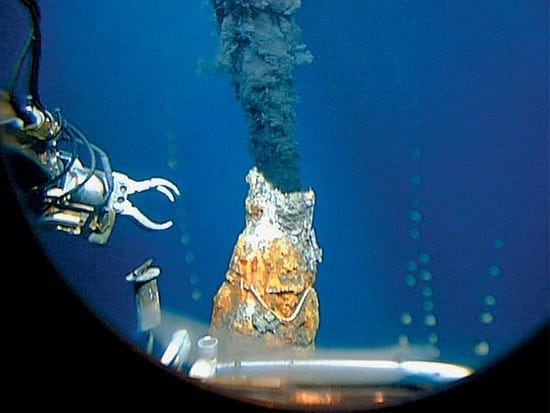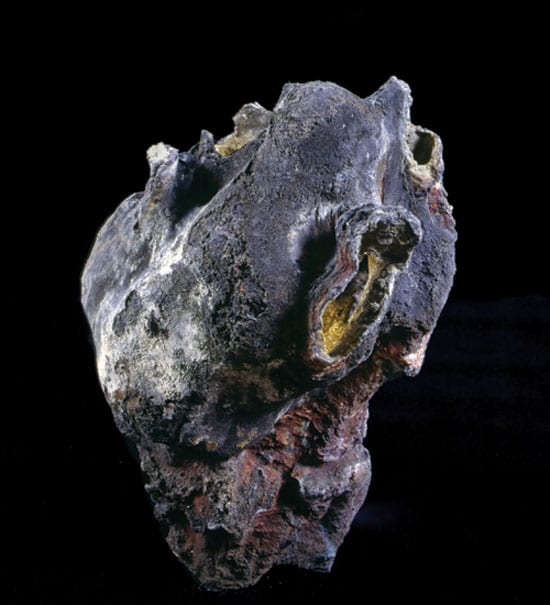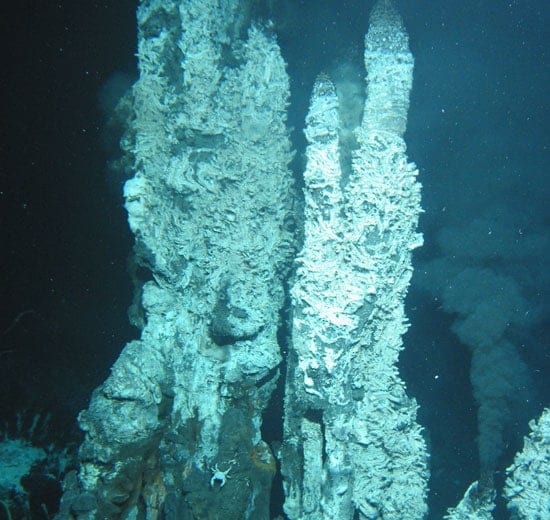Deep Sea Floor Mining Is Subject of International Colloquium at WHOI
March 26, 2009
Scientists, policymakers, environmentalists, and industry representatives will gather next week at Woods Hole Oceanographic Institution (WHOI) to discuss the issue of mining precious metals from the seafloor. A public colloquium, which will feature keynote addresses from leading voices on the subject and a panel discussion, will be held on Thursday, April 2, from 2 to 5 p.m. in WHOI’s Redfield Auditorium, Woods Hole, MA. The event, the 5th Elisabeth and Henry Morss Jr. Colloquium, is free and open to the public and will also be broadcast in real time on the Web.
Recent proposals for seafloor mining have centered on massive sulfide deposits—rich in copper, gold, silver, and zinc—that are found at deep-sea hydrothermal vent systems.
Vent systems are part of the planet’s plumbing system and form in places where there is volcanic activity, such as along Mid-Ocean Ridges. Water seeps into cracked seafloor and is heated by hot, and sometimes molten rock deep in the ocean crust. The hot fluid becomes buoyant, rises rapidly back to the seafloor, and gushes out of the vent openings at temperatures as high as 400°C. This hydrothermal fluid carries with it dissolved metals and other chemicals from deep beneath the ocean floor, but, at just below the seabed, these metals can precipitate to form seafloor massive sulfide (SMS) deposits.
“Scientists are still in the early stages of studying these SMS deposits, but the active vent sites that generate them can often also play host to species and ecosystems that were previously unknown to science,” said Maurice Tivey, a senior scientist at WHOI. “The new frontier of deep-sea exploration and mining raises questions about the sustainable use of these resources and potential environmental impacts. This colloquium represents an invaluable—and extremely timely—opportunity to discuss all of the various scientific, political, legal, and economic implications of mining with the people most knowledgeable about it.”
Working with the Census of Marine Life’s ChEss (Chemosynthetic Ecosystems) project, InterRidge, Ridge 2000, and the Deep Ocean Exploration Institute at WHOI, Tivey and colleagues have organized a scientific workshop that has attracted more than 100 participants from 20 countries to explore the subject. During the workshop, which will be held the day before the public event, scientists and students of all disciplines will exchange ideas and research results arising from investigations of hydrothermal vent systems and the seafloor deposits that form around them.
“The enthusiastic response of the international community to this meeting highlights sea floor mining as an issue of important global implications,” said Jian Lin, a WHOI geophysicist and InterRidge Chair.
The public colloquium will provide a summary of the previous day’s workshop.
Commercial sea floor mining is already being planned offshore Papua New Guinea, and in May, the International Seabed Authority, which implements the UN Convention on the Law of the Sea, will finalize its rules opening up the high seas to these activities. The U.S. currently has not ratified the Law of the Sea convention.
Among the speakers at next week’s colloquium is Nii Allotey Odunton, the Secretary-General for the International Seabed Authority, which will oversee the regulation of the world’s seafloor resources. Also speaking are Caitlyn Antrim, the executive director for the Rule of Law Committee for the Oceans, Rod Eggert, the division director for economics and business at the Colorado School of Mines, and Maurice Tivey, a geologist at WHOI who studies these unique deep sea environments. They will be joined by Samantha Smith, environmental manager of Nautilus Minerals Inc., Sabine Christiansen of the World Wildlife Fund, and Chris German, a WHOI geochemist who is co-chair of ChEss and InterRidge, for a panel discussion and Q&A with the audience.
“The issue of deep-sea mining of SMS is of global importance, connected to the global economy, society, and the conservation of unique marine life,” said German. “Before these unique environments are altered by industrial processes, we scientists hope to gain and exchange as much information as we can about the formation, preservation, and distribution of SMS deposits to determine the gaps in our scientific knowledge.”
The Morss Colloquium will broadcast in real time on the Web at http://www.whoi.edu/workshops/deepseamining.
The Woods Hole Oceanographic Institution is a private, independent organization in Falmouth, Mass., dedicated to marine research, engineering, and higher education. Established in 1930 on a recommendation from the National Academy of Sciences, its primary mission is to understand the oceans and their interaction with the Earth as a whole, and to communicate a basic understanding of the oceans’ role in the changing global environment.



